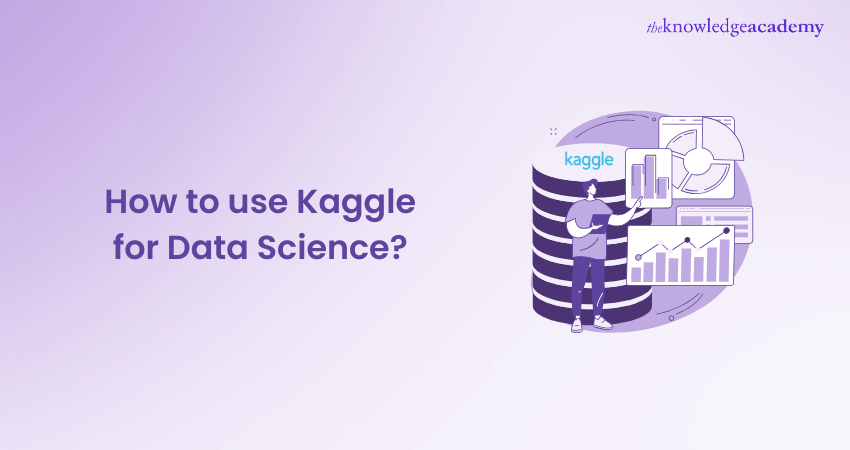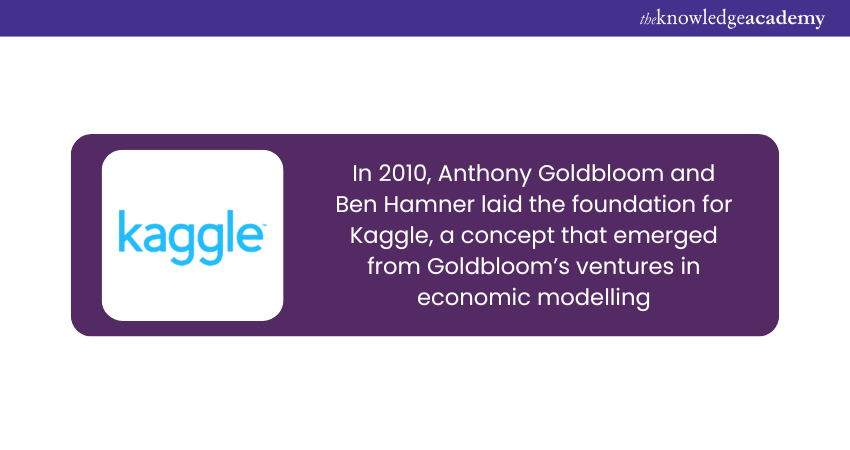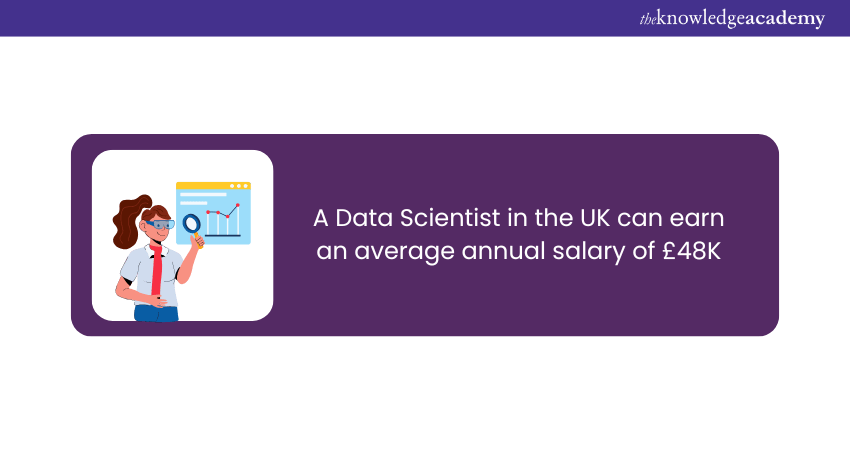We may not have the course you’re looking for. If you enquire or give us a call on +47 80010068 and speak to our training experts, we may still be able to help with your training requirements.
We ensure quality, budget-alignment, and timely delivery by our expert instructors.

Whether you are handling your first dataset or engaging in exciting battles in global Machine Learning (ML) competitions, Kaggle is the ultimate playground for Data Science dreamers. Its vibrant community, top-notch resources and remarkable range of tools ensure that there's something for everyone. This blog explores How to Use Kaggle for Data Science, including its advantages and the essential skills that can turn your curiosity into mastery. So read on and take your Data Science journey to the next level!
Table of Contents
1) What is Kaggle?
2) Advantages of Kaggle
3) How to use Kaggle for Data Science?
4) Essential Skills for Excelling on Kaggle
5) How do I get Started on Kaggle as a Beginner?
6) Can I use Kaggle to Build My Portfolio?
7) Conclusion
What is Kaggle?
Kaggle is an online platform that assembles Data Scientists, Machine Learning practitioners, and Statisticians from around the world. It was founded in 2010 and is now owned by Google. Kaggle offers a wide range of tools and resources to help data enthusiasts practice and improve their skills.
Kaggle hosts numerous competitions sponsored by organisations, ranging from classifying images and predicting medical outcomes to identifying fraudulent transactions. By participating, you can submit your models and see how they perform on a public leaderboard. You can also receive feedback from other competitors and the bigger Kaggle community.
Advantages of Kaggle
Kaggle offers numerous advantages for data enthusiasts and professionals in the field of Data Science. Here are some key benefits of using Kaggle:
a) Access to Diverse Datasets: Kaggle provides a vast repository of datasets covering various domains, from healthcare to finance. This access to diverse data allows Data Scientists to work on real-world problems and gain practical experience.
b) Participation in Competitions: Kaggle hosts a wide range of Data Science competitions, some with substantial cash prizes. These competitions allow participants to apply their skills to solve challenging problems, learn from their peers, and even earn recognition in the field.
c) Kaggle Kernels: Kaggle Kernels offer a Cloud-based environment for running code. They make it easy to experiment with data, build models, and share your work with the Kaggle community. This tool is invaluable for collaborative projects and quick Data Analysis.
d) Learning resources: Kaggle provides free, high-quality courses on Data Science, Machine Learning (ML), and Artificial Intelligence. Such courses are suitable for beginners and advanced learners, helping individuals acquire new skills and advance their careers.
e) Community Collaboration: Kaggle has a thriving community of Data Scientists and enthusiasts. Users can discuss projects, seek advice, and learn from others. Collaboration is encouraged, making Kaggle a supportive environment for skill development.
f) Data Visualisation Tools: Data Visualisation is a crucial part of Data Analysis and communication. Kaggle offers tools and resources for creating insightful visualisations, helping Data Scientists effectively convey their findings.
g) Career Advancement: Kaggle experience is highly regarded by employers in the Data Science industry. Listing Kaggle’s achievements on your resume can help you stand out and advance your career. It showcases your practical skills and problem-solving abilities.
h) Progress Tracking: Kaggle tracks your achievements and progress, providing a sense of accomplishment as you overcome challenges and improve your skills.
i) Open-source Contributions: Kaggle's datasets and code are often open-source. By contributing to Kaggle, you can give back to the Data Science community and help others learn and grow.
j) Networking Opportunities: Engaging with Kaggle can lead to networking opportunities within the Data Science field. You can connect with professionals, mentors, and potential collaborators.

How to use Kaggle for Data Science?
Kaggle has established itself as a pivotal resource for data enthusiasts. Whether you're a novice or an experienced Data Scientist, here's a step-by-step guide on effectively utilising Kaggle for your Data Science journey:
a) Create a Kaggle Account: To get started, you need to sign up for a Kaggle account. You can do this through your email or Google account.
b) Navigate Kaggle's Interface: Familiarise yourself with Kaggle's user-friendly interface. This includes exploring the homepage, datasets, competitions, and learning resources.
c) Explore Kaggle Datasets: Begin by browsing Kaggle's extensive dataset collection. Use filters and search features to find datasets aligned with your interests and projects.
d) Participate in Kaggle Competitions: Select a competition that matches your skill level and interests. Consider forming or joining a team to tackle challenges collaboratively. Compete to solve real-world problems and potentially earn prizes.
e) Leverage Kaggle Kernels: Create Kaggle Kernels to work on data projects. Utilise these Cloud-based computational environments for coding and Data Analysis.
f) Engage with Kaggle Courses: Choose from Kaggle's wide range of courses to enhance your Data Science Skills. Start with introductory courses if you're a beginner, and progress to more advanced topics like Deep Learning.
g) Collaborate with the Kaggle Community: Join discussions, forums, and threads on Kaggle. Seek advice, share your knowledge, and collaborate on data projects with other Kagglers.
h) Master Data Visualisation: Utilise Kaggle's data visualisation tools, including libraries like Matplotlib and Seaborn. Create impactful visualisations to communicate insights effectively.
Take the next step in your Data Science journey with our Advanced Data Science Certification. Sign up today!
Essential Skills for Excelling on Kaggle
To be successful on Kaggle, there are certain skills you should focus on developing. These include:

1) Analytical Thinking and Business Insights
It's the ability to approach complex Data Science problems with a structured and logical mindset. Kaggle presents a lot of real-world problems that require in-depth analysis, and analytical thinking is what allows Data Scientists to navigate these challenges effectively.
Analytical Thinking involves dissecting intricate problems into smaller, solvable components. It's about asking the right questions, identifying patterns and trends, and, most importantly, aligning data-driven solutions with the broader business context. While data and algorithms are essential, it's the business insights drawn from the data that often lead to meaningful, actionable results.
2) Effective Communication and Storytelling
Data visualisation plays a pivotal role in conveying complex data insights. Whether you're working on a Kaggle competition or a personal project, creating visual representations of your data can make your findings more accessible and engaging. Tools like Matplotlib, Seaborn, and Plotly enable you to craft compelling charts, graphs, and interactive dashboards that illustrate your results and tell a story.
A well-documented project or codebase is a testament to your professionalism. It allows you to do the following:
a) Explain your methods
b) Share your thought processes
c) Enable others to replicate your work
It's not just about the final results but the journey you took to get there. When you can convey not just what you did but why and how you did it, you're facilitating collaboration and knowledge sharing within the Kaggle community.

3) Strong Affinity for Statistics and Mathematics
Kaggle is an exciting platform that allows Data Scientists and Machine Learning practitioners tackle complex real-world problems, and a deep understanding of Statistics and Mathematics is crucial for making meaningful contributions.
Statistics provides the tools for
a) Analysing data
b) Drawing inferences
c) Making predictions
Competitions on Kaggle often involve developing predictive models and statistical concepts like
a) Probability theory
b) Hypothesis testing
c) Regression analysis
These play a pivotal role in constructing accurate and effective models.
Master the fundamentals of probability and Statistics for Data Science excellence. Join our Probability and Statistics for Data Science Training today!
4) Proficiency in Machine Learning
It's important to understand the core concepts of Machine Learning. This includes grasping the different types of Machine Learning Algorithms, such as
a) Supervised
b) Unsupervised
c) Reinforcement learning
Proficiency in supervised learning, where models are trained on labelled data, is particularly important for many Kaggle competitions. You should be well-versed in various algorithms that include:
a) Decision trees
b) Support vector machines
c) Neural networks
Also, learn to understand when and how to apply them.
It's also crucial to have hands-on experience with Machine Learning libraries and frameworks like
a) Scikit-learn,
b) TensorFlow
c) PyTorch
These tools streamline the implementation of Machine Learning models and provide access to pre-built algorithms. By gaining practical experience in model building, evaluation, and optimisation, you can develop the skills needed to excel in Kaggle competitions.

How do I get Started on Kaggle as a Beginner?
You can begin by signing up for a free account, exploring datasets, and starting with the “Learn” section, which offers Python, Machine Learning, and data visualisation tutorials. You can also participate in beginner-friendly competitions or explore public notebooks to learn from others.
Can I use Kaggle to Build My Portfolio?
Yes, you can showcase your skills by participating in competitions, uploading well-documented notebooks, and contributing to discussions. These activities help spotlight your expertise to potential employers or collaborators.
Conclusion
In conclusion, Kaggle is a valuable reservoir for Data Science enthusiasts that offers datasets, tools, and competitions to engage in and elevate your skills. Learning How to Use Kaggle for Data Science involves understanding its numerous benefits and the crucial skills needed to achieve Data Science excellence, as this blog outlines.
Master Data Visualisation, Data Preprocessing and Data Warehousing through our comprehensive Data Mining Training - sign up today to enhance your career!
Frequently Asked Questions
Can You Use Kaggle for SQL?

Yes, you can use Kaggle to learn SQL. It offers kernels, competitions, and other immersive learning opportunities for SQL Programming Language.
How can Kaggle’s Notebooks Feature Help in Building and Sharing Projects?

Kaggle’s Notebooks feature help in building and sharing projects through:
a) Interactive environment
b) Access to datasets
c) Free GPU/TPU Access
d) Support for collaboration
e) Rich media support
f) Community engagement
What are the Other Resources and Offers Provided by The Knowledge Academy?

The Knowledge Academy takes global learning to new heights, offering over 3,000 online courses across 490+ locations in 190+ countries. This expansive reach ensures accessibility and convenience for learners worldwide.
Alongside our diverse Online Course Catalogue, encompassing 19 major categories, we go the extra mile by providing a plethora of free educational Online Resources like News updates, Blogs, videos, webinars, and interview questions. Tailoring learning experiences further, professionals can maximise value with customisable Course Bundles of TKA.
What is The Knowledge Pass, and How Does it Work?

The Knowledge Academy’s Knowledge Pass, a prepaid voucher, adds another layer of flexibility, allowing course bookings over a 12-month period. Join us on a journey where education knows no bounds.
What are the Related Courses and Blogs Provided by The Knowledge Academy?

The Knowledge Academy offers various Data Science Courses, including the Python Data Science Course and the Pandas for Data Analysis Training. These courses cater to different skill levels, providing comprehensive insights into What is Data Science.
Our Data, Analytics & AI Blogs cover a range of topics related to Data Science, offering valuable resources, best practices, and industry insights. Whether you are a beginner or looking to advance your Data Science skills, The Knowledge Academy's diverse courses and informative blogs have got you covered.
Upcoming Data, Analytics & AI Resources Batches & Dates
Date
 Data Science and Blockchain Training
Data Science and Blockchain Training
Fri 4th Apr 2025
Fri 6th Jun 2025
Fri 8th Aug 2025
Fri 3rd Oct 2025
Fri 5th Dec 2025






 Top Rated Course
Top Rated Course



 If you wish to make any changes to your course, please
If you wish to make any changes to your course, please


